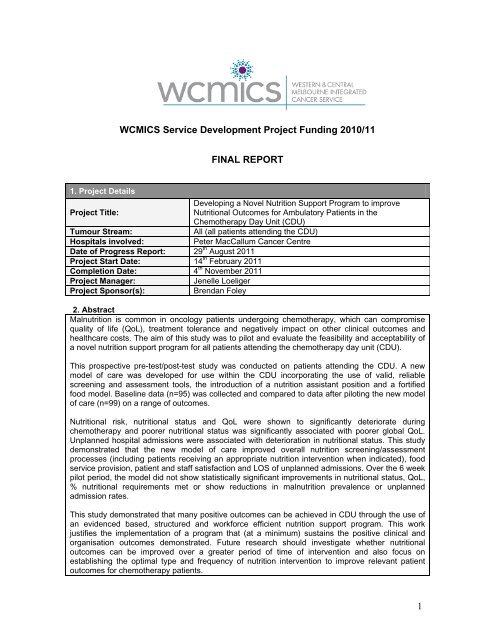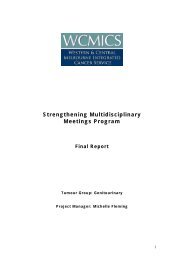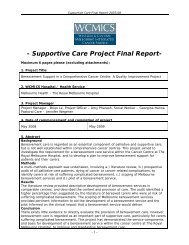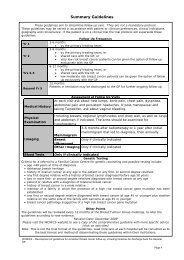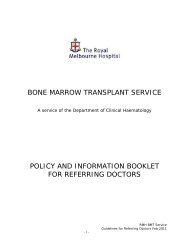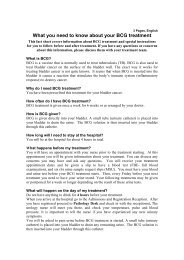Developing a Novel Nutrition Support Program to improve ... - wcmics
Developing a Novel Nutrition Support Program to improve ... - wcmics
Developing a Novel Nutrition Support Program to improve ... - wcmics
- No tags were found...
You also want an ePaper? Increase the reach of your titles
YUMPU automatically turns print PDFs into web optimized ePapers that Google loves.
WCMICS Service Development Project Funding 2010/11FINAL REPORT1. Project Details<strong>Developing</strong> a <strong>Novel</strong> <strong>Nutrition</strong> <strong>Support</strong> <strong>Program</strong> <strong>to</strong> <strong>improve</strong>Project Title:<strong>Nutrition</strong>al Outcomes for Ambula<strong>to</strong>ry Patients in theChemotherapy Day Unit (CDU)Tumour Stream:All (all patients attending the CDU)Hospitals involved:Peter MacCallum Cancer CentreDate of Progress Report: 29 th August 2011Project Start Date: 14 th February 2011Completion Date: 4 th November 2011Project Manager:Jenelle LoeligerProject Sponsor(s):Brendan Foley2. AbstractMalnutrition is common in oncology patients undergoing chemotherapy, which can compromisequality of life (QoL), treatment <strong>to</strong>lerance and negatively impact on other clinical outcomes andhealthcare costs. The aim of this study was <strong>to</strong> pilot and evaluate the feasibility and acceptability ofa novel nutrition support program for all patients attending the chemotherapy day unit (CDU).This prospective pre-test/post-test study was conducted on patients attending the CDU. A newmodel of care was developed for use within the CDU incorporating the use of valid, reliablescreening and assessment <strong>to</strong>ols, the introduction of a nutrition assistant position and a fortifiedfood model. Baseline data (n=95) was collected and compared <strong>to</strong> data after piloting the new modelof care (n=99) on a range of outcomes.<strong>Nutrition</strong>al risk, nutritional status and QoL were shown <strong>to</strong> significantly deteriorate duringchemotherapy and poorer nutritional status was significantly associated with poorer global QoL.Unplanned hospital admissions were associated with deterioration in nutritional status. This studydemonstrated that the new model of care <strong>improve</strong>d overall nutrition screening/assessmentprocesses (including patients receiving an appropriate nutrition intervention when indicated), foodservice provision, patient and staff satisfaction and LOS of unplanned admissions. Over the 6 weekpilot period, the model did not show statistically significant <strong>improve</strong>ments in nutritional status, QoL,% nutritional requirements met or show reductions in malnutrition prevalence or unplannedadmission rates.This study demonstrated that many positive outcomes can be achieved in CDU through the use ofan evidenced based, structured and workforce efficient nutrition support program. This workjustifies the implementation of a program that (at a minimum) sustains the positive clinical andorganisation outcomes demonstrated. Future research should investigate whether nutritionaloutcomes can be <strong>improve</strong>d over a greater period of time of intervention and also focus onestablishing the optimal type and frequency of nutrition intervention <strong>to</strong> <strong>improve</strong> relevant patien<strong>to</strong>utcomes for chemotherapy patients.1
3. Introduction (background, purpose of the project)Background, purpose of the projectBackground and literature reviewMalnutrition is common in patients with cancer, with the prevalence reported as 40-80% ofpatients¹. In the ambula<strong>to</strong>ry chemotherapy day setting it can be incorrectly assumed that thesepatients are ‘more well’ because they are not admitted for treatment, yet recent research hasindicated that the prevalence of malnutrition is in the vicinity of 26% for this patient group 2 . Theconsequences of malnutrition include impairment of immune function, performance status, musclefunction, quality of life (QOL), reduced response <strong>to</strong> chemotherapy, more severe chemotherapyinduced<strong>to</strong>xicity and complications and survival times are shortened 3 . Whilst there is increasingevidence that an <strong>improve</strong>ment in dietary intake can <strong>improve</strong> these outcomes 4 there is an absenceof adequately powered studies which assess the impact of nutrition interventions on endpointssuch as survival, QOL or nutritional status in the chemotherapy patient 5 . Some recent evidenceinvestigating dietetic intervention in the hospitalised patient receiving chemotherapy showed no<strong>improve</strong>ment in nutritional status 6 and that dietetic advice and nutritional supplements in thechemotherapy patient group demonstrated no significant <strong>improve</strong>ments in clinical, nutritional andquality of life endpoints 5 , however methodological issues in both of these published studies limit thevalidity of these conclusions in clinical practice. Further high quality nutrition research is thereforeneeded in this patient group that examines the effect of intensive nutrition support programs usingstandardised pro<strong>to</strong>cols on meaningful clinical outcomes such as QOL, nutritional status, unplannedhospital admissions and <strong>to</strong>lerance <strong>to</strong> chemotherapy regimens.There is overwhelming evidence in the literature indicating weight loss and malnutrition are adverseprognostic fac<strong>to</strong>rs in patients with cancer 6 and that appropriate screening and assessment <strong>to</strong>detect patients at risk of becoming malnourished are important <strong>to</strong> implement effective nutritionstrategies 7 . Despite this, it is common that in areas with high patient numbers such aschemotherapy day units, many lower skilled tasks such as nutrition screening, direct patientassistance and recording of food and supplement consumption are not performed due <strong>to</strong> limiteddietetic (and nursing) resourcing. Chemotherapy patients have additional energy and proteinrequirements during the treatment phase and yet a large proportion are unable <strong>to</strong> meet theseneeds for a multitude of reasons. This may include nutrition impact symp<strong>to</strong>ms such as nausea andvomiting, reduced appetite, mucositis, taste changes and diarrhoea; additional requirementsassociated with the metabolic effect of the cancer itself or a combination of both 6 . Broader fac<strong>to</strong>rssuch as treatment duration as well as fatigue and lethargy after treatment can influence a patient’sability <strong>to</strong> prepare nourishing meals when they return home after treatment. In the inpatient setting,the intake of hospital foods can be increased significantly in a variety of different ways: byimproving the eating ambiance, reducing or eliminating distractions, improving the menu andcatering service, increasing the energy density of the food and ensuring that snacks andsupplements are available 4 and yet none of these strategies have been evaluated in theambula<strong>to</strong>ry chemotherapy setting.At Peter Mac, approximately 750 patients undergo chemotherapy in the CDU per month. A pointprevalence malnutrition risk study undertaken in 2009 identified 34% of patients attending the CDUare at risk of malnutrition and 0% of patients at risk of malnutrition were captured by currentnutrition practice 4 . The current nutrition service <strong>to</strong> the CDU relies on referrals from other healthprofessionals and is limited by resourcing. Current nutrition practice in the CDU is that dietitians arereferred patients based on the predicted side effects of chemotherapy regimens, rather than anindividualised process which takes in<strong>to</strong> account weight/body composition status, disease type,dietary intake, level of functioning, current nutrition impact symp<strong>to</strong>ms and metabolic demands.Yet despite all of these fac<strong>to</strong>rs, CDU patients are only offered a low energy and protein meal ontheir day of treatment. This consists of a lunch of one sandwich, soup and jelly with a piece of cakemid meals which approximately meets 20-25% of a typically recommended daily intake for energy2
and protein. Not only is the CDU food provision of low nutritional value, it caters poorly forvegetarians, patients requiring special diets (ie. Soft, pureed and gluten-free diets) or fromculturally diverse backgrounds. The menu is the same every day, which can result in taste fatigueand boredom. Furthermore, in 2009 a patient satisfaction survey undertaken in the Peter Mac CDUidentified that 25% of patients reported that the food provided in CDU failed <strong>to</strong> meet their nutritionalor organoleptic needs 5 .This model <strong>to</strong> be developed at Peter Mac strongly aligns with the VCAP and WCMICS priorityareas, and will be highly transferable across other WCMICS sites and hospitals around Australia.Limited dietetic funding has meant that past strategies implemented by dietitians in the CDU whichaimed at improving patient nutritional and health outcomes have not been conducted as researchstudies, had sufficient patient numbers <strong>to</strong> demonstrate significance or have not been evaluatedsufficiently. The purpose of this project is <strong>to</strong> evaluate the provision of a proactive model of caredelivery <strong>to</strong> ambula<strong>to</strong>ry chemotherapy patients which encompasses targeted malnutrition screeningand assessment, effective workforce planning and the provision of nourishing foods. The study willinclude adequate patient numbers <strong>to</strong> determine the statistical significance of interventions andrelevant clinical outcome measures <strong>to</strong> ensure a robust evaluation in order <strong>to</strong> inform futurerecommendations for nutrition services within the CDU.Project objective and expected outcomesThe objective is <strong>to</strong> pilot and evaluate the feasibility and acceptability of a novel nutrition supportprogram for all patients attending CDU;1. Undertake a literature review and collect/develop all relevant <strong>to</strong>ols2. Collect baseline data on usual nutrition practice in CDU3. Pilot the new model of care through a program of nutrition assistants and targeted nutritionsupport in order <strong>to</strong> <strong>improve</strong> both patient centred outcomes and the service delivery model4. Form recommendations for the potential implementation/integration of the new program in<strong>to</strong>usual care.This project aims <strong>to</strong> strengthen nutrition support of patients undergoing chemotherapy throughtimely and screening/identification and treatment of all patients at risk of malnutrition. Thisinnovative and previously untested model of care will complete the continuum of nutritional care forpatients during their cancer journey as it complements a synergistic project, the Peter MacMalnutrition Inpatient Strategy. This project also promotes sustainable workforce initiatives throughthe integration of a nutrition assistant under the support of a dietitian and the multidisciplinary CDUteam.With the implementation of a new model of care, the expected outcomes are <strong>to</strong>:1. Reduce the incidence of malnutrition in CDU2. Improve the % of patients screened for malnutrition risk who attend CDU3. Improve % of patients that receive an appropriate nutrition intervention4. Improve/maintain nutritional status of patients undergoing chemotherapy5. Improve energy/protein intake of patients undergoing chemotherapy6. Improve health related quality of life (QOL)7. Improve patient and staff satisfaction with the provision of the new model of care(specifically with the nutritional care and food in CDU) and demonstrate acceptability <strong>to</strong>patients and staff8. Improve patients <strong>to</strong>lerance <strong>to</strong> treatment9. Decrease the number of unplanned nutrition-related admissions10. Increase the number and frequency of nutrition intervention by either the dietitian ornutrition assistant as specified by the model of care3
References:1. Laviano A, Meguid MM. <strong>Nutrition</strong>al issues in cancer management. <strong>Nutrition</strong>. 1996; 12 (5):358-371.2. Isenring E, Cross G, Daniels L, Kellett E, Koczwara B. Validity of the malnutrition screening <strong>to</strong>ol as an effectivepredic<strong>to</strong>r of nutritional risk in oncology outpatients receiving chemotherapy. <strong>Support</strong> Care Cancer. 2006; 14: 1152-1156.3. Van Cutsem E, Arends J. The causes and consequences of cancer-associated malnutrition. Eur J Oncol Nurs.2005; 9: s51-s63.4. Elia M. <strong>Nutrition</strong>, hospital food and in-hospital mortality. Clin Nutr. 2009 June; 28: 481-483.5. Baldwin C, Spiro A, McGough C, Norman AR, Gillbanks A, Thomas K et al. Simple nutritional intervention inpatients with advanced cancers of the gastrointestinal tract, non-small cell lung cancers or mesothelioma andweight loss receiving chemotherapy: a randomised controlled trial. J Hum Nutr Diet. 2011; 24: 431-440.6. Capra S, Ferguson M, Reid K. Cancer: impact of nutrition intervention outcome-nutrition issues for patients.<strong>Nutrition</strong>. 2001; 17(9): 769-772.7. Isenring E, Bauer J, Capra S. The effect of intensive dietetic intervention on the nutritional status of hospitalisedpatients on chemotherapy. Nutr Diet. 2004; 61(1): 46-49.4. MethodologySpecify any changes from Project Plan provided in Progress Project ReportSummary of methodology included under Project Activities in section 5. See Appendix 1 – ProjectPlan for complete methodology.5. Project activities, findings, outcomes including evidence of achievementSpecify any information/<strong>to</strong>ols developed and suitable/applicable for sharing across the WCMICSProject activities and outputs for each of the 4 stages of the projectStage Activity Timeline Outputsa) Literature review 1.5b) Ethics application monthsc) Recruitment and (mid-Febtraining of project staff – endd) Development of all Marchrelevant data collection 2011)<strong>to</strong>olse) Establish project teamand regular meetings1 –Developmenta) Literature review completedb) Ethics application submitted andapprovedc) Recruitment and training of all projectstaff completed adequatelyd) Tools for data collection developede) Project team and meetings established(every 4-6 weeks)2 – Baseline(collection ofbaselinedata)a) Baseline datacollection on allparameters as perProject Plan2.5months(startApril –mid-June2011)a) N = 95 patient consented/recruited;i. Data collected from all recruitedpatients at 2 timepoints - day 1 ofchemotherapy and 6 wks later.ii. Parameters collected includedmalnutrition risk score, nutritionalstatus, QOL, weight/anthropometry,dietary intake (specifically energyand protein intake), unplannedadmissions, treatment breaks (due<strong>to</strong> in<strong>to</strong>lerances) or changes <strong>to</strong>dosages of chemotherapy etc,number of interventions by thedietitian3 – Pilot(collection ofa) Implementation of newmodel of care2.5monthsa) New model of care implementedb) N = 99 patient consented/recruited;4
pilot data)b) Pilot data collection onall parameters ascollected in baselinestage(mid-June –end Aug2011)i. Data collected from all recruitedpatients at 2 timepoints - day 1 ofchemotherapy and 6 wks later.ii. Parameters collected includedmalnutrition risk score, nutritionalstatus, QOL, weight/anthropometry,dietary intake (specifically energyand protein intake), unplannedadmissions, treatment breaks (due<strong>to</strong> in<strong>to</strong>lerances) or changes <strong>to</strong>dosages of chemotherapy etc,number of interventions by thedietitian4 -Evaluationa) Data analysis of bothbaseline and pilotcohortsb) Collate results anddisseminatec) Formrecommendations forimplementation andintegration of the newmodel of care in<strong>to</strong>usual care2 months(start-Sept –4 th NovOct2011)a) Data analysis completed on bothbaseline and pilot cohorts andcomparison between the twob) Results collated and presented below in‘summary of outcomes’c) Recommendations below in ‘summaryof outcomes’Information and <strong>to</strong>ols developed as part of the project (refer <strong>to</strong> Appendices 3-6)1. Chemotherapy screening criteria for au<strong>to</strong>matic referral <strong>to</strong> dietitian (appendix 3)Chemotherapy screening criteria for au<strong>to</strong>matic referral <strong>to</strong> the dietitian was already in practice prior <strong>to</strong>the commencement of the project. This set of criteria specifies particular known high nutritional riskchemotherapy regimens and/or particular tumour streams and enables an early referral <strong>to</strong> the dietitianprior <strong>to</strong> the high likelihood of nutritional deterioration occurring. This set of criteria was updated basedon the latest evidence in conjunction with professional consensus and was used during the both thebaseline and pilot periods (note, used as an adjunct <strong>to</strong> screening with the MST in pilot period), as se<strong>to</strong>ut in the model of care (appendix 4).2. Model of care (appendix 4)A new model of care was developed and piloted during Stage 3 of this project. This novel model aimed<strong>to</strong> <strong>improve</strong> the current nutrition service delivery model through the use of nutrition assistants andtargeted nutrition support in order <strong>to</strong> <strong>improve</strong> patient centred outcomes. The model incorporates:a) Malnutrition screening with a valid, reliable screening <strong>to</strong>ol (Malnutrition Screening Tool,MST)b) Appropriate nutrition assessment by the dietitian with a valid, reliable assessment <strong>to</strong>ol(Patient Generated Subjective Global Assessment, PG-SGA)c) Chemotherapy screening criteria for au<strong>to</strong>matic referral <strong>to</strong> the dietitiand) Triaging based on level of malnutrition risk <strong>to</strong> help direct patients <strong>to</strong> the most appropriatenutrition intervention and help clinicians prioritise workloade) Taking in<strong>to</strong> account effective workforce strategies and limited dietetic resourcing, lowerskilled/priority tasks (nutrition screening, direct patient assistance, moni<strong>to</strong>ring of food andsupplement consumption, basic nutrition education/counselling etc) are directed <strong>to</strong> the5
nutrition assistant and the higher skilled/more complex tasks (nutrition assessment, intensenutrition education/counselling, artificial feeding etc) are directed <strong>to</strong> the dietitianf) Minimum frequency of nutrition intervention for patients at risk of malnutritiong) Provision of a fortified food model of more nourishing foods/fluids for all patients on CDU,including nutrition supplements for those at highest risk.3. Menus and posters about foods/fluids on CDU (appendix 5)During the pilot period, a number of resources were developed <strong>to</strong> assist in raising awareness of thefood/fluids available <strong>to</strong> patients on CDU – these included menus on the food service trolley and posterson the walls around CDU.4. Patient education material (appendix 6)A new patient resource was developed for the nutrition assistant <strong>to</strong> provide <strong>to</strong> patients during Stage 3of the project - ‘Good nutrition during your chemotherapy and at home’. This education materialexplains the important of nutrition during/after chemotherapy and provides practical advice andsuggestions about how patients can achieve adequate nutrition.Summary of outcomesThe following demographic data is a summary at week 1 in both the baseline and pilot periods andindicates the 2 cohorts are generally comparable:Baseline period Pilot period – Difference– week 1 week 1Median Age (y) 63 59 Not significantMedian Weight (kg) 72.7 73.5 Not significantMedian Height (m) 1.66 1.70 Not significantMedian BMI (kg/m 2 ) 26.3 25.2 Not significantGender, n (%)MaleFemale46 (48.4%)49 (51.6%)52 (52.5%)47 (47.5%)Not significantTumour Stream, n (%)BreastGynaecologyHead & NeckHaemLower GILungSarcomaSkinUpper GIUrology11 (11.6%)6 (9.5%)17 (17.9%)18 (18.9%)6 (6.3%)16 (16.8%)1 (1.1%)8 (8.4%)8 (8.4%)1 (1.1%)9 (9.1%)11 (11.1%)21 (21.2%)20 (20.2%)5 (5.1%)6 (6.1%)3 (3.0%)14 (14.1%)7 (7.1%)3 (3.0%)P=0.022Chemotherapy only, n (%) 65 (68.4%) 70 (70.7%) Not significantCombined chemoradiation, n (%) 30 (31.6%) 29 (29.3%) Not significantPrevious chemo, n (%) 36 (37.9%) 30 (30.3%) Not significantDietitian intervention wk 1, n (%) 35 (36.8%) 37 (37.4%) Not significantScreened as high risk Tx, n (%) 27 (28.4%) 26 (26.3%) Not significant6
1. Implementation of a new model of care:• Malnutrition screening processes:o Introduced malnutrition screening for all patients attending the CDU using areliable/valid <strong>to</strong>ol the Malnutrition Screening Tool, MST (previously not in place)o Malnutrition screening conducted by nursing staff and details enteredelectronically in<strong>to</strong> CHARM (electronic patient management system)o High compliance rate in completing screening with the new model• <strong>Nutrition</strong> assessment processes:o Introduction of a CDU nutrition assistant (NA) as the crucial link between the<strong>Nutrition</strong> Department, CDU staff and the Food Services Departmen<strong>to</strong> Patients triaged depending on malnutrition risk:‣ No risk - screened on next visit <strong>to</strong> the CDU‣ Low risk - basic ‘Eating well during treatment’ education by the NA‣ High risk - provision of hot meal and nutritional supplements, education andtailored intervention by the dietitian (minimum fortnightly review by dietitian)• Food service provision:o More nourishing foods for all patients attending the CDUo Extra afternoon tea round (maintain existing 2pm round plus addition of newround at 4pm) due <strong>to</strong> high volume of patients in CDU in afternoono Inclusion of more nourishing snacks (higher energy and/or protein) for allpatients such as Fruche, yoghurt, custard tarts, Tim Tamso Greater variety of foods/fluids on offero High protein soups for all patientso Ceased lower calorie and/or protein foods on menu eg. jellyo <strong>Nutrition</strong>al supplements now targeted <strong>to</strong> the highest risk patients and for thosepatients where a clinical need existso Menus and posters placed on CDU <strong>to</strong> raise patient awareness of food/fluid onoffero Cessation of visi<strong>to</strong>rs consuming food/fluids – service targeted <strong>to</strong> patientso Patient Service Assistants now offer the full menu range (and offer nourishingfoods/fluids first)o All changes <strong>to</strong> the food/fluid on offer in CDU were approximately cost neutral:Overall food/supplement cost: Baseline Pilot Difference CommentsWeekly cost $ 1,227.00 $ 1,275.00 $ 48.00 3.8% increase• The implementation of a new model of care included the successful introduction of malnutritionscreening, the nutrition assistant role in CDU, targeted nutrition interventions and an <strong>improve</strong>dprovision of food/fluids including nutritional supplements – collectively this substantially<strong>improve</strong>d the overall nutrition service <strong>to</strong> patients in CDU2. Malnutrition prevalence in CDUOutcome measure Baseline Pilot DifferenceMalnutritionprevalence (PG-SGA)• Week 1• Week 635.9%44.3%29.3%39.4%Not significantWeight (median)• Week 1 72.7kg 75.3kg Not significant7
• Week 6 72.2kg 72.8kg% weight change(median)Loss of 1.2% Loss of 1.3% Not significant• During both baseline and the pilot periods:oMalnutrition prevalence increased significantly between weeks 1 and 6 ofchemotherapy for both the baseline (p=0.033) and the pilot (p
• During both the baseline and pilot periods:o Malnutrition risk according <strong>to</strong> the MST increased significantly between week 1 and6 of chemotherapy (see table above) (p
5. Change in nutritional status of patients undergoing chemotherapyOutcome measure Baseline Pilot DifferenceChange in PG-SGA categorybetween week 1 & 6 (<strong>to</strong>tal n=88):• Improved• Maintained• WorsenedPG-SGA score (median)• Week 1• Week 6n= 13 (14.8%)n= 52 (59.1%)n= 23 (26.1%)7 [IQR: 4-13]10 [IQR: 5-17]n= 9 (9.1%)n= 65 (65.7%)n= 21 (21.2%)5 [IQR 3-10]8 [IQR 3-14]Not significantNot significantChange in PG-SGA score(median) between week 1 & 6 +2 [IQR: -3-+7] +1 [IQR -3 <strong>to</strong> +5] Not significant• During both the baseline and pilot period:o <strong>Nutrition</strong>al status significantly deteriorated between week 1 and week 6, asindicated by a median increase in the PG-SGA score (refer <strong>to</strong> table for values) forboth the baseline (p=0.01) and pilot periods (p
Emotional functioning No change ImprovedCognitive functioning No change** No changeSocial functioning Worsened** Worsened*** High score for function scales/QoL represents high/healthy level of functioning/QoL** Indicates a statistically significant result (p
• Patient satisfaction with the dietitian remained high during both the baseline and pilotperiods and was high for the nutrition assistant when implemented during the pilot period• Patient satisfaction <strong>improve</strong>d in all domains of care during the pilot period with theimplementation of the new model of care.• More patients were offered food during the pilot period and this equated <strong>to</strong> a highproportion of meals consumed during this time.Outcome measure –BaselinePilotDifferencestaff satisfaction with:(n=27)(n=25)Screening 4.9 7.4 ImprovementCapturing malnutrition 3.7 7.3 ImprovementRescreening N/A 6.9 N/AReferral system 5.5 7.7 ImprovementResponse times 7.3 8.4 Improvement<strong>Nutrition</strong> management 7.4 8.4 ImprovementFood provided for patients 3.6 7.2 ImprovementTeam communication 5.0 7.3 Improvement<strong>Nutrition</strong>al care provided N/A 68% agree/strongly agree N/A• Staff satisfaction (including dietitians, doc<strong>to</strong>rs and nursing staff) <strong>improve</strong>d substantially inall domains of care during the pilot period with the implementation of the new model of care• Overall, both patient and staff satisfaction <strong>improve</strong>d substantially during the pilot period with theimplementation of the new model of care when compared with baseline• Patients were more likely <strong>to</strong> consume their meals during chemotherapy if they were offeredthem and if they met their dietary requirements9. Patients <strong>to</strong>lerance <strong>to</strong> treatment during the first 12 weeks of chemotherapyPts <strong>to</strong>lerance <strong>to</strong> chemo during wk 1-12Percentage (%)50454035302520151050Chemo not completedas prescribedMissed dose Delayed dose Dose reductionOutcom e m easureBaselinePilot12
Outcome measure Baseline Pilot DifferenceNo (%) of pts that did not complete theirn=44 (46.3%) n=42 (42.4%) Not significantchemotherapy as prescribedNo (%) of pts that missed a dose of prescribed n=24 (25.3%) n=30 (30.3%) Not significantchemotherapyNo (%) of pts that had a delayed dose ofn=18 (18.9%) n=8 (8.1%) P=0.007prescribed chemotherapyNo (%) of pts that had a dose reduction ofprescribed chemotherapyn=19 (20%) N=2 (2%) p1 unplanned admission**<strong>Nutrition</strong> related admissions= feeding tube insertions, loss of weight, poor oral intake, dehydration..13
• During the baseline and pilot periods:o Patients who had unplanned admissions experienced significantly greater loss ofweight than those who were not admitted both in the baseline (-5.1% vs. 0%,p=0.001) and in the pilot periods (-3.5% vs. -0.9%, p=0.031)• LOS was not correlated with change in PG-SGA score or weight change during the first 6weeks of chemotherapy in either the baseline or pilot periods• A high proportion of chemotherapy patients have unplanned admissions• A high proportion of chemotherapy patients that have an unplanned admission are admitted fora nutrition related reason (37.5-40.5%)• Whilst not statistically significant, there was a shorter length of stay of those patients withunplanned admission during the pilot period compared with the baseline.• The <strong>to</strong>tal number of nutrition related admission days (no. of nutrition related admissions xmedian nutrition related LOS) was reduced during the pilot period when compared with baseline(60 days vs 72 days respectively). As unplanned admissions were linked with increasednutritional deterioration at both time points, earlier nutrition intervention may have the potential<strong>to</strong> provide significant cost savings <strong>to</strong> the organisation.11. The number and frequency of nutrition intervention between week 1 & 12 chemotherapy byeither the dietitian or nutrition assistant as specified by the model of careOutcome measure Baseline Pilot DifferenceNo. of patients who received nutritioninterventionn=44 (46.3%) n=58 (58.6%) Improvement(p=0.014)• By dietitian onlyn=44 (46.3%) n=38 (38.4%)• By NA onlyn=0 (0%) n=12 (12.1%)• Combination of dietitian & NAn=0 (0%) n=9 (9%)No. of patients who received non=51 (53.7%) n=41 (41.4%) Improvementnutrition interventionMedian no. of dietitian reviews forhigh risk patients(p=0.014)4 5 Not significant• During the baseline period:o Dietitians provided 100% of the nutrition interventions for patients identified asrequiring intervention (no NA in place).• During the pilot period:o 9% of patients received ‘shared care’ being seen by the dietitian and the NAo The new model of care has shifted up <strong>to</strong> 21% of nutrition interventions thatpreviously would have been provided by the dietitian (or not at all) <strong>to</strong> the NA–highlighting the workforce efficiency of the NA in the new model of care.o Of the 28 patients that were deemed as high risk in week 1, 92.9% (n=26) wereseen minimum of fortnightly for at least the initial 6 weeks of chemotherapy as perthe model of care.• The proportion of patients receiving nutrition intervention <strong>improve</strong>d significantly during thepilot period when compared with baseline (p=0.014).• Overall, the proportion of patients receiving nutrition intervention significantly <strong>improve</strong>d duringthe pilot period when compared with baseline• The use of the NA <strong>to</strong> provide nutrition intervention is an effective workforce strategy enablingthe NA <strong>to</strong> complete lower skilled tasks/nutrition interventions and the dietitian <strong>to</strong> providespecialised, complex nutrition interventions <strong>to</strong> those most in need.14
6. Limitations/Deviations for Project PlansMinor changes/deviations were made <strong>to</strong> the original Project Plan at the commencement of theproject:1. Project methodology – all outputs were completed at the required time-points and theplanned measures were utilised. Additional audits were conducted on CDU during stage 2(baseline) <strong>to</strong> better understand the food service provision/systems which then informedthe development of the new model of care for implementation in stage 3 (pilot).2. Project deliverables – each stage of the project was delivered as per the Project Plan3. Gantt chart/timeline – each stage of the project was completed on time and as planned4. Project scope – the project remained within scope and did not deviate from the ProjectPlan5. Project resources and budget – the project was delivered within budget. Additional timewas required for the Grade 1 Project Dietitian for data analysis beyond the end of theStage 3 – this was provided as in-kind support by the <strong>Nutrition</strong> Department.6. Project risk management – risks were identified at the commencement of the project andappropriate mitigation plan instituted – these were all appropriately managed. A new riskemerged during the project with staff losses (nursing and PSA’s) in CDU which wassuccessfully managed with increased education/inservicing <strong>to</strong> all relevant CDU staff.7. RecommendationsInclude a description of how this project will be sustainable and transferable across othertumour streams and sites1. Interim or short-term plan for sustainabilityAn interim sustainability plan was implemented from the completion of Stage 3 through <strong>to</strong> theend of project (and will remain until final project recommendations are implemented). The NAposition ceased at the completion of Stage 3 due <strong>to</strong> the project resource allocation, thereforethis short-term plan was established in CDU during this time <strong>to</strong> maintain the essentialcomponents of the model of care. This included:• Malnutrition screening – No change <strong>to</strong> the piloted model of care: the CDU nursingstaff continued <strong>to</strong> complete malnutrition screening with the MST on all CDU patientsat each chemotherapy cycle. This was continued <strong>to</strong> be inputted using the CHARMcomputer program on CDU.• Triage and nutrition intervention – Changes made <strong>to</strong> the piloted model of care: thedietitians continued <strong>to</strong> see all referrals generated from the criteria for au<strong>to</strong>maticreferral, all high risk patients generated from the MST (score of 4 or 5) and frommultidisciplinary team referral at any time. The low risk patient group (MST score of 2or 3) previously had nutrition intervention from the NA, however in this interim phasethis patient group was provided with nutrition education material by designatednursing staff.• Food services – No changes made <strong>to</strong> the piloted model of care: the positive foodservices changes including more nourishing snacks for all patients and the provisionof hot meals and nutritional supplements for high risk patients has remained thesame. This has remained approximately cost neutral.15
2. Long-term plan for sustainabilityRecommendations for the long-term sustainability of this project are as follows:• Malnutrition screening - The CDU nursing staff will continue <strong>to</strong> completemalnutrition screening with the MST on all CDU patients at each chemotherapy cycle.This will be continued <strong>to</strong> be inputted using the CHARM computer program on CDU.• Triage and nutrition intervention – Implement the piloted model of care byreconfiguring current resourcing within the <strong>Nutrition</strong> Department, this includes:oo<strong>Nutrition</strong> intervention for the low risk patient group (MST score of 2 or 3) willbe provided by the NA. It is recognised that the NA plays a pivotal role ofbeing the link between the CDU staff, Food Services and the <strong>Nutrition</strong>Department. The ability <strong>to</strong> provide a <strong>Nutrition</strong> Department presence will assistwith compliance with malnutrition screening, which has shown <strong>to</strong> havedeclined during the interim phase without the NA being on CDU. Theinpatient NA’s current role will be reconfigured <strong>to</strong> include the tasks assignedin the model of care including seeing the low risk patients on the CDU andthe provision of hot meals and nutritional supplements <strong>to</strong> all high riskpatients. This will aid compliance with malnutrition screening and providepreventative strategies <strong>to</strong> those patients that are at low risk of malnutritionincluding: a verbal basic nutrition education, written education material andregular follow up by the CDU nutrition assistant.The dietitians will continue <strong>to</strong> see all referrals generated from the criteria forau<strong>to</strong>matic referral (<strong>to</strong> be updated at regular intervals), all high risk patientsgenerated from the MST (score of 4 or 5) and from multidisciplinary teamreferral at any time.• Food services - The positive food services changes including more nourishingsnacks for all patients and the provision of hot meals and nutritional supplements forhigh risk patients has remained the same. This has remained cost neutral.• Ongoing quality measures - The following quality measures will be completed bythe senior dietitian who is responsible for Peter Mac’s malnutrition portfolio. They willbe implemented <strong>to</strong> measure ongoing acceptability, effectiveness and feasibility of thenew model of care:ooooooooKPI: Number (%) of patients screened for malnutrition risk (monthly)Audit: Number (%) of patients in each category of risk (MST 0-5) (6 monthly)Audit: Number of patients malnourished at any one point in time on CDU(annual point prevalence audit)Audit: Number (%) of ‘at risk’ patients seen by the nutrition assistant and thedietitian (6 monthly)Audit: Number (%) of nutrition related admissions and <strong>to</strong>tal nutrition relatedadmission days in chemotherapy patients compared with CDU project(annual)Survey: Staff and patient satisfaction of the nutrition and food services <strong>to</strong>patients on the CDU (annual)Moni<strong>to</strong>ring: Moni<strong>to</strong>r costs ($) of food service provision (including nourishingmeals, snacks and supplements on the CDU) (monthly)Moni<strong>to</strong>ring: Moni<strong>to</strong>r consumption/popularity of meals, snacks and nutritionalsupplements on the CDU (annual)16
• Ongoing education - Planned future education and training in regards <strong>to</strong> malnutritionprevention and treatment in the CDU setting is as follows:ooooEnsure all staff conducting malnutrition screening (using MST) areappropriately trained and competent in its use (CDU nurses) and implement astrategy for educating new nursing staffEnsure that all staff in-servicing includes relevant updates on malnutrition ona regular basis (minimum of 6 monthly)Ensure that all PSA’s on the CDU are appropriately trained in appropriateprovision of food/fluids <strong>to</strong> patientsEnsure ongoing training of the dietitians and nutrition assistants throughdepartmental continuing education program3. Transferability across other sitesAll of the work completed as part of this project could be utilised and/or implemented byother <strong>Nutrition</strong> Departments and CDU’s across the WCMICS region at a local level. Theneeds of each specific site would need <strong>to</strong> be evaluated in the first instance and then thefollowing reports and <strong>to</strong>ols could be applied:• Outcomes and findings from the final project report• Model of care piloted• Menu and posters regarding food services on CDU• Patient education material• Chemotherapy screening criteria for au<strong>to</strong>matic referrals <strong>to</strong> the dietitianThe final project report and an executive summary will be forwarded <strong>to</strong> each of theWCMICS hospitals <strong>Nutrition</strong> Department Heads on completion. The project team is veryhappy <strong>to</strong> provide in-servicing and/or be contacted about strategies for implementation atlocal sites as needed.8. ImplementationPlease see ‘long term plan for sustainability’ in ‘7. Recommendations’ for the plannedimplementation strategies.9. Expenditure reportBudget itemProject Manager – grade 4Head of <strong>Nutrition</strong>DepartmentProject Officer – grade 3senior clinician/dietitian(0.2EFT for 8.5 months)Project Dietitian – grade 1dietitian (0.5EFT for 5months)Project <strong>Nutrition</strong> Assistant(0.8EFT for 3 months)Original forecastamountFinal amount spent Comment$0 $0 In-kind supportfrom <strong>Nutrition</strong>Department$14180 $13800$15453 $14800$9943 $930017
Equipment (1x computer) $0 $0 Shared with othernutrition-fundedWCMICS projectConsumables $0 $0Administration $200 $200Total amount (includingGST & on-costs)$39,775 $38,10010. Project Manager (Applicant) signatureI declare that this report is a true and proper representation of the activities undertaken in thisproject…11. Project Sponsors signatureI fully endorse this report and its content…12. Participating Hospitals Clinical LeadsI fully endorse this report and its content…Amber Kelaart (Senior Dietitian/Clinician & Project Officer):13. Appendix:Appendix 1 - Project Plan - please attach <strong>to</strong> this report (for example a Gantt chart)Appendix 2 - Project Progress ReportAppendix 3 - Tools/resources developed: chemotherapy screening criteria for au<strong>to</strong>matic referral<strong>to</strong> dietitianAppendix 4 - Tools/resources developed: model of careAppendix 5 - Tools/resources developed: menus and posters about food/fluids on CDUAppendix 6 - Tools/resources developed: patient education material18


